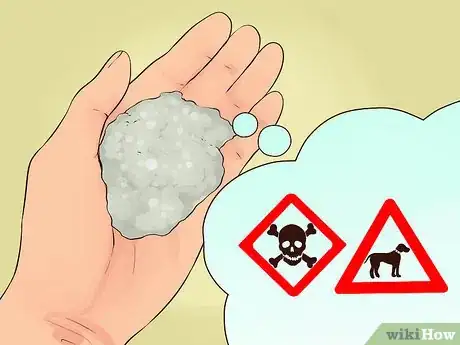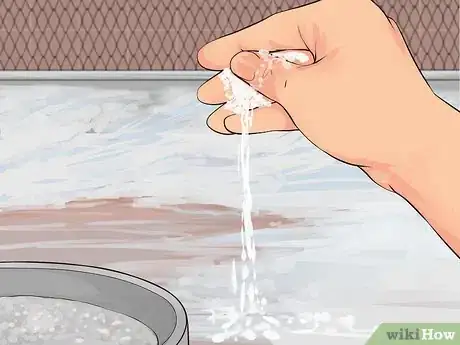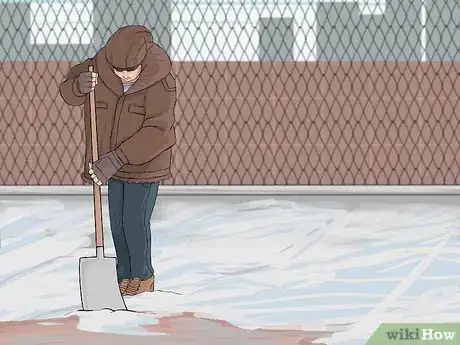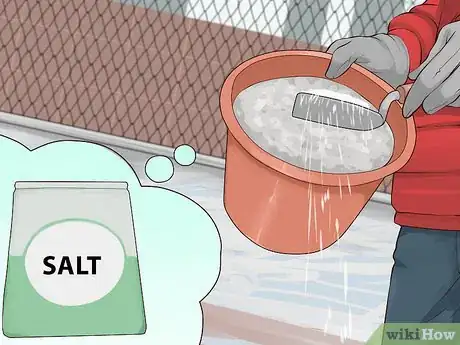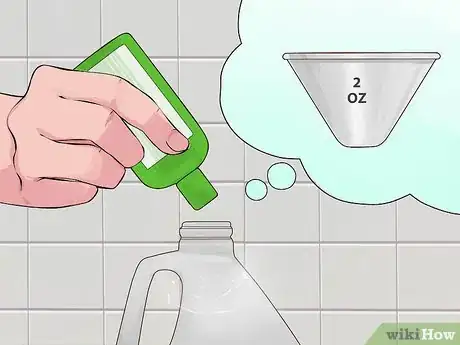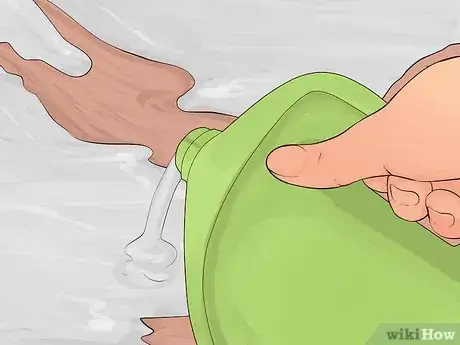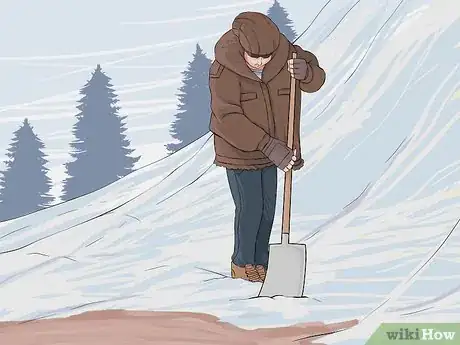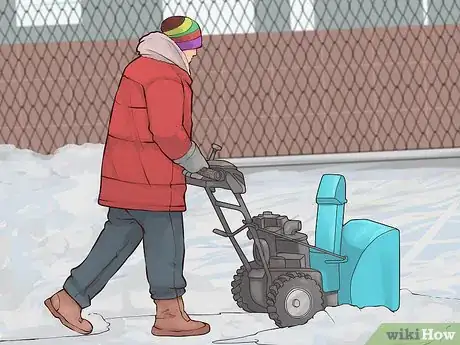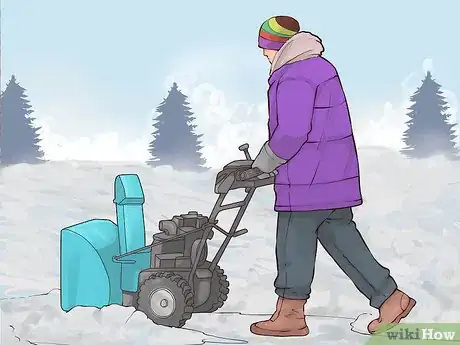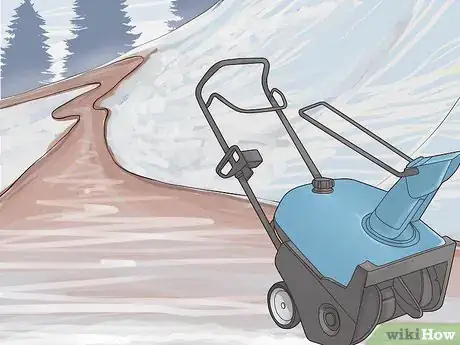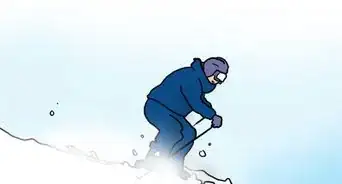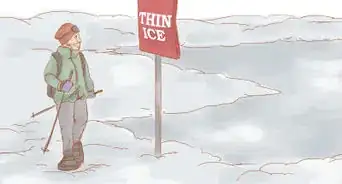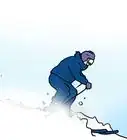X
This article was co-authored by wikiHow Staff. Our trained team of editors and researchers validate articles for accuracy and comprehensiveness. wikiHow's Content Management Team carefully monitors the work from our editorial staff to ensure that each article is backed by trusted research and meets our high quality standards.
This article has been viewed 103,764 times.
Learn more...
An icy sidewalk can be a safety hazard to you, your family and your neighbors. Many cities have laws requiring you to clear ice off the sidewalk which runs through your property. It is best to know how to quickly, safely and efficiently clear that ice away.
Steps
Method 1
Method 1 of 3:
Using Deicers
-
1Purchase a deicer. You should be able to find these at your local hardware store. It is best to buy several bags at the beginning of the season. Once the first snow storm hits, it is possible that stores will sell out of the product.[1]
- You should store your deicer in a dry place, preferably inside an airtight container keeping it free from moisture and sunlight.[2]
- These are largely made of rock salt, or sodium chloride, which has a lower freezing point than water. This allows it to seep through the ice, breaking it up and creating a layer of water beneath it.
-
2Use the right product correctly. Deicers can be harmful to your health, your sidewalk, your lawn and your pets. Don’t use too much of it, and sweep it up after the ice has thawed. If you feel the need to use more than 2-4 ounces per square yard, you may be using the wrong product for your purposes. Ice melts function at a variety of temperatures and melt at different speeds.[3]
- Hygroscopic ice melt removes moisture and can be severely damaging to skin and sidewalks.[4]
- Some of these products involve more chemicals than others. Urea is sometimes included in the mixture, but can cause damage to your sidewalk.
- Calcium chloride will melt ice at even lower temperatures than salt mixtures without it. It can function at -20 degrees Fahrenheit, whereas salt is only good down to 15 degrees Fahrenheit. This is useful for melting ice quickly when you need it on stairs or walkways, but will need to be reapplied often.
- Rock salt takes longer to melt the ice, but will not require being reapplied as often. Use this in areas used less often, like driveways.
Advertisement -
3Sprinkle a small amount of deicer on the icy sidewalk. It is not necessary to use a lot of salt. Create a thin layer of salt on top of the ice. You want to use about 2-4 ounce or 1-2 handfuls per square yard.[5]
- It is best to sprinkle this layer of salt as soon as it starts to snow. Once the ice gets thicker, it will be more difficult for the salt to be effective.
- The salt should start working in 15-30 minutes. It will not melt the ice, but should have seeped through and made a layer of water between the ice and the sidewalk, as well as breaking up the layer of ice and making it easier to shovel.
-
4Shovel the ice off your sidewalk. Now that the ice has been broken down, it should be easy to break apart and remove with a snow shovel. Tap the tip of the blade of the shovel against the ice to break it apart.
- Holding one hand on the top of the handle and the other down another foot or so along the length of the shovel, wedge the blade under the broken ice.
- Scoop the shovel under as much ice as you can and lift it off the sidewalk.
- Turn and tip the load of ice over to the side of the sidewalk and continue shoveling until it is cleared.
-
5Lay down a second layer of salt. You can use salt before, during and after a snowstorm. Laying down a layer after you complete your shoveling will help keep more ice from forming. If the snow continues or returns, you will already have your deicer working at the lower level to make future ice removal easier.[6]
Advertisement
Method 2
Method 2 of 3:
Making Your Own "Ice Melt"
-
1Fill a gallon jug with warm water. You will want to fill the container half way for a total of 1/2 gallon of warm water. Don’t worry about making the water very hot. It should still be cool enough to handle.[7]
-
2Add dish soap. Using whatever liquid dish soap you have handy, squeeze six drops of dish soap into the gallon jug. Gently roll your wrist to mix the soap into the water without making it foam.
-
3Finish the mixture with rubbing alcohol. Measure out 2 ounces of rubbing alcohol. You can use an alcohol jigger for an accurate measurement. Add these two ounces of rubbing alcohol to the gallon jug.[8]
- Rubbing alcohol, or isopropyl alcohol, can be hazardous. Take precautions when handling it. Avoid contact with skin by wearing gloves. Don't touch your face after handling rubbing alcohol. Wash your hands with a lot of soap and water.[9]
-
4Pour the mixture onto the ice. While the water is still warm, pour it generously over the ice which you would like to remove. The solution will break down the ice and make it easier to shovel.[10]
-
5Shovel the ice. You will want to remove the ice safely and efficiently. This means getting the ice and snow out of the path for walking and driving without hurting yourself in the process.[11]
- Use a lightweight snow shovel which is not too heavy for you.
- Decide where you will pile the snow and ice before you start so that you don’t end up blocking a walking or driving path and needing to start over in that area.
- Ideally, just push the snow and ice out of the way without lifting it.
- If you do lift, keep your knees bent and back straight. Remember to do the lifting with your legs and only lift as high as necessary to move the ice to your pile. If you are turning, turn your whole body instead of twisting at the waist.
Advertisement
Method 3
Method 3 of 3:
Using a Snowblower
-
1Choose a heavy duty machine. Snowblowers can possibly handle some ice and save your back from shoveling injuries. If there are chunks of ice mixed in with your snow, the right snow blower can handle the job.
- Avoid single-stage blowers which use paddles and choose a dual-stage snow blower, which employs augers. Some augers have sharper or longer teeth, which are useful in breaking up the ice.
- Gas blowers tend to be more reliable and stronger than electric blowers.
-
2Break up the ice. Snow blowers will not be able to remove a sheet of ice. This will likely register as solid ground and the blower will roll over it. Break up large sheets of ice with a shovel before using the snow blower.
-
3Read the owner’s manual. Each snow blower will come with different controls, options and instructions. Be sure that you understand all of the moving parts and how to use them by reading the instruction manual before using the blower.
- Pay specific attention to how to operate the auger, chute direction, drive clutch and steering levers.
- Prepare the snowblower with gasoline, oil, stabilizers or necessary extension cords.
- Look for accessories which may have come with your snow blower, like blades, skid shoes and shear pins.
-
4Plan your route. Know where you want to place the snow and ice. Decide which side of the sidewalk you would like to blow and pile the snow. Never blow ice and snow toward cars, houses or other people. Don’t move the snow from your sidewalk into someone else’s path.[12]
- If it is a windy day, don’t blow the snow into the wind. This will blow it back in your direction.
- Avoid picking up and shooting gravel through the blower. If you are clearing a gravel surface, leave a little snow on top of the gravel by lifting the necessary blades or augers to a height which does not reach completely to the ground.
-
5Start your snow blower in a ventilated area. You will want to start the snowblower outside or in an open area. If you are in a shed or a garage, make sure that the doors are open to let exhaust out.[13]
-
6Move the snowblower slowly over the area you are clearing. Use both hands to push the blower at a slow and steady pace, much like mowing the lawn. Follow your planned route and take care when making turns.[14]
- Some second-stage blowers have power steering options to assist in making turns.
- Disengage augers when making turns and make sure that the chute is facing the correct direction before starting the augers back up.
- Continue pushing the snow blower over the area and making turns until the sidewalk is completely cleared.
Advertisement
Warnings
- Don't slip on the ice, it can break bones or crack your head. Be extremely careful when doing this!⧼thumbs_response⧽
- Wear warm clothing.⧼thumbs_response⧽
- Don't refuel a snow blower while it is running.⧼thumbs_response⧽
- Never place your hands near the auger of a snow blower.⧼thumbs_response⧽
Advertisement
References
- ↑ http://www.todayshomeowner.com/how-to-use-deicers-and-anti-icers-on-sidewalks-and-driveways/
- ↑ http://blog.regdist.com/6-important-tips-to-safely-and-effectively-use-ice-melt
- ↑ http://blog.regdist.com/6-important-tips-to-safely-and-effectively-use-ice-melt
- ↑ http://blog.regdist.com/how-magnesium-calcium-chloride-ice-melt-is-destroying-your-facility#TypesOfIceMelt
- ↑ http://blog.regdist.com/6-important-tips-to-safely-and-effectively-use-ice-melt
- ↑ http://blog.regdist.com/6-important-tips-to-safely-and-effectively-use-ice-melt
- ↑ https://www.youtube.com/watch?v=E0jWmGyZxrc
- ↑ https://www.youtube.com/watch?v=E0jWmGyZxrc
- ↑ http://nj.gov/health/eoh/rtkweb/documents/fs/1076.pdf
- ↑ https://www.youtube.com/watch?v=E0jWmGyZxrc
- ↑ http://nj.gov/health/eoh/rtkweb/documents/fs/1076.pdf
- ↑ https://www.snowblowersatjacks.com/quick-tips-snowblower-operation.aspx
- ↑ https://www.snowblowersatjacks.com/quick-tips-snowblower-operation.aspx
- ↑ https://www.snowblowersatjacks.com/quick-tips-snowblower-operation.aspx
About This Article
Advertisement

